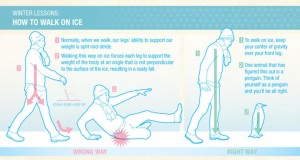Walking on ice is fierce. While I actually appreciate the extremity of the cold this winter, I feel for the older people in my building who seem consigned to the indoors for the season.
Walking my dog the other night the street and sidewalks were a stunning sheet of treacherous ice full of slipping pedestrians.
A friend sent me this infographic on Facebook and I appreciate it though I think it got it all wrong. My response when I first received it was that we all need to walk a little more like penguins so I thought I would elaborate on this.
A different approach to the same graphic is that we should all be walking, not more like penguins but as if we are always walking on ice. In an earlier post about walking on ice I wrote that everyone tends to fall backwards on their butt because their posture and movement patterns are always pulling us backwards, hence the falling backwards.
The infographic suggests that walking correctly won’t work on ice which strikes me as a little silly. It is our poor movement and posture patterns that cause us to fall while walking on ice.
The idea isn’t really to walk like a penguin but to get our legs under our hips and our trunk properly over the pelvis. We can be upright while the penguin can’t due to the miracle of the lumbar curve of the spine.
We aren’t the only bipedal creatures but we are the only bipedal animal with a curved lower spine.
It is the curve of the lower, or lumbar, spine that bears weight and absorbs shock to allow us to be upright.
But the curve of the lower spine is also what allows us to habitually lean backwards and fall on our butt while walking on ice.
Such a conundrum.
***

